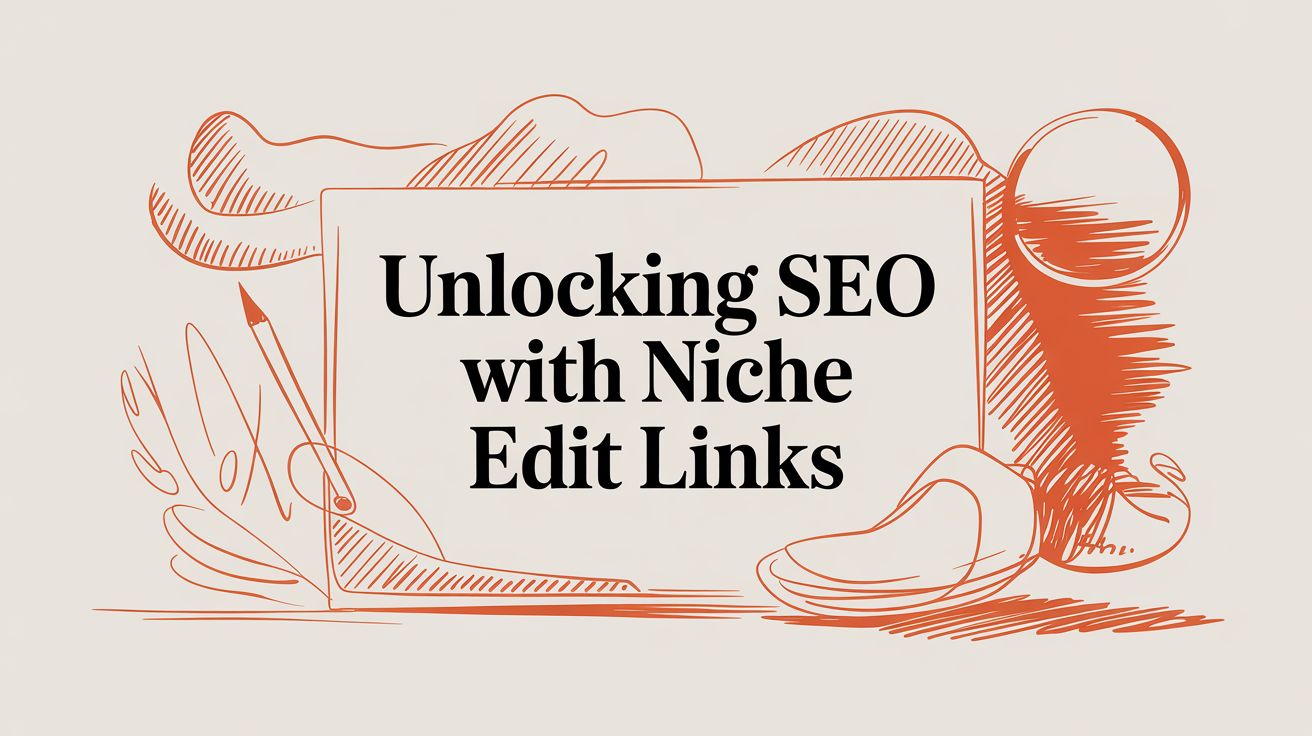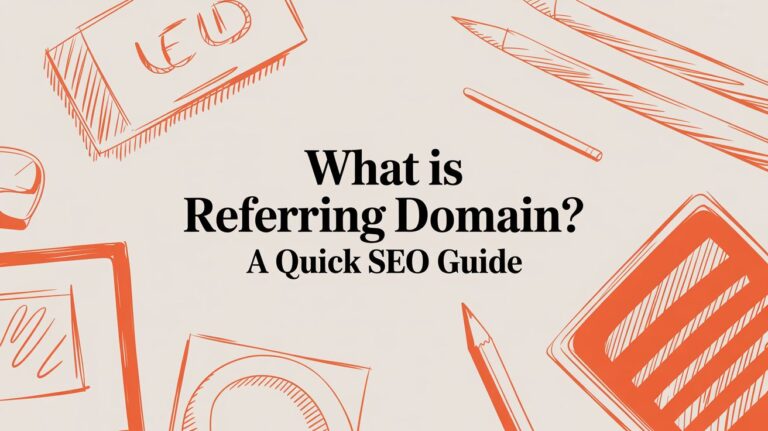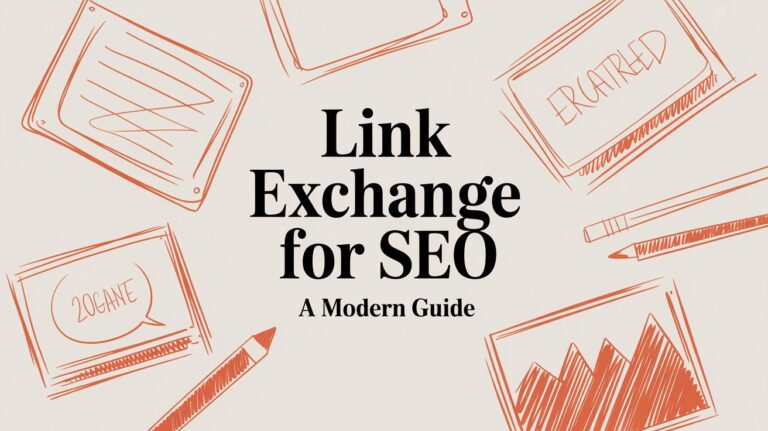Unlocking SEO with Niche Edit Links
A niche edit link is a backlink inserted into an existing article on another website. Instead of writing a new guest post, you find a relevant, aged piece of content and add your link contextually.
This strategy gets your link on a page that Google already knows, trusts, and has indexed, giving you a powerful head start.
Unlocking SEO Power with Niche Edit Links

Imagine a popular, well-respected travel guide about your city. Now, imagine adding a mention of your new boutique hotel directly into the chapter on “Best Places to Stay.” That’s the essence of a niche edit link.
This SEO strategy bypasses the lengthy process of creating new content. Instead, you pinpoint a high-quality, established article and insert a natural, contextual link pointing to your site. It’s a digital renovation—you’re enhancing an existing structure, not building a new one.
The Advantage of Aged Authority
The magic of niche edits lies in the power of aged content. A blog post that’s been online for months or years has built authority, rankings, and trust with search engines. When you place your link inside that article, some of that hard-earned credibility flows to your site.
A niche edit link acts as a vote of confidence from a source that search engines already respect. This “borrowed” authority can lead to faster ranking improvements compared to links from brand-new articles.
This approach offers clear advantages for any business looking to improve its SEO.
Key Benefits of Niche Edit Links
- Faster SEO Impact: Because the hosting page is already indexed and ranking, search engines credit your new backlink much faster. There’s no “sandbox” period for a new post to gain traction.
- High Topical Relevance: You can be selective, choosing articles that perfectly match your content. This ensures the link is contextually relevant—a crucial factor for modern search algorithms.
- Reduced Content Overhead: This method eliminates the need to research, write, and pitch new guest posts, freeing up significant time and resources.
- Access to Established Traffic: A link on a page that already gets organic traffic can become a source of highly qualified referral visitors to your website.
Ultimately, niche edit links are an efficient and powerful tool for building a stronger backlink profile. By tapping into the authority of aged content, you can accelerate your SEO results and build a more commanding online presence.
The Hidden SEO Power of Aged Content
What makes a niche edit link so effective? It all comes down to leveraging the authority content builds over time.
An endorsement from a respected, long-standing expert carries more weight than one from a newcomer. In SEO, an aged web page is that expert. A page that’s been live for years has a history with Google. It has been crawled, indexed, and has seen real user engagement, building a foundation of trust that a new article can’t match.
When you place a link within this established content, you get a powerful vote of confidence from a source search engines already value.
How Authority Flows Through Niche Edits
This transfer of power is called “link equity.” Think of it as SEO momentum. An older, authoritative page has built this momentum through its history of earning traffic and backlinks. A niche edit creates a bridge, allowing some of that momentum to flow to your website.
This is different from a typical guest post, where your link lives on a page starting with zero authority. A new article must build its credibility from scratch, a process that can take months. A niche edit skips this waiting game, delivering value almost instantly.
A link from an aged, indexed article sends a much stronger signal to search engines than a link from a new post. It’s the difference between a recommendation from a tenured professor versus a first-year student.
The Critical Role of Topical Relevance
Age and authority are only part of the story. The real impact comes from combining them with topical relevance. Placing your link in an article closely related to your content creates a logical connection that search engines favor.
For example, if you sell email marketing software, a link from a five-year-old article titled “Advanced Email Marketing Strategies” is a perfect fit. The context signals to Google that your site is a legitimate resource on that topic, reinforcing your expertise.
This potent mix of existing authority and direct relevance is why niche edits are a go-to link-building strategy. You’re not just creating content and hoping it ranks; you’re inserting contextual links into articles that are already indexed and often ranking well. The key, as explained by seoptimer.com, is ensuring the link placement is natural and adds value within a highly relevant paragraph.
This immediate impact makes niche edit links an incredibly efficient tactic. They tap into pre-existing authority to deliver faster SEO results and bring valuable traffic from an audience already interested in your topic.
How to Acquire Niche Edit Links Safely
Acquiring niche edit links involves a spectrum of tactics, from ethical outreach to risky paid shortcuts. The goal is to build links that provide long-term value without jeopardizing your site.
Focus on sustainable strategies that align with search engine guidelines. By understanding the difference between “white hat” and “gray hat” approaches, you can build a powerful and penalty-proof backlink profile that delivers lasting results.
The White Hat Method: Broken Link Building
The safest and most respected way to earn niche edits is through broken link building. This strategy is about providing genuine value. You act as a helpful editor for other websites by finding dead links on their pages and offering your relevant content as a replacement.
This approach is a win-win: the site owner fixes an issue that hurts their user experience, and you earn a powerful, contextually relevant backlink. It’s a strategy built on mutual benefit and is favored by SEOs who prioritize sustainable growth.
This decision tree illustrates the logic behind a powerful link opportunity.
The key takeaway is that a link’s strength comes from the combination of existing authority (aged content) and a natural fit (relevance).
How to Find Niche Edit Opportunities
There are several paths to acquiring niche edits, each with its own pros, cons, and risks.
Niche Edit Acquisition Methods Comparison
| Method | Description | Risk Level | Best For |
|---|---|---|---|
| Broken Link Building | Find dead links on relevant sites and suggest your content as a replacement. | Low | Anyone seeking high-quality, sustainable links with some outreach effort. |
| Direct Outreach | Contact site owners and ask for a link to be added to existing, relevant content. | Low | Brands with strong content that enhances another article. |
| Paid Placements (Direct) | Pay a website owner an “editorial fee” to insert a link into an existing article. | Medium to High | Experienced SEOs who can thoroughly vet sites and understand the risks. |
| Link Brokers & Agencies | Use a third-party service to secure placements with publishers. | Medium to High | Teams with a budget who need to scale link building but must vet the provider carefully. |
The best method depends on your resources, risk tolerance, and goals. While paid options can seem like a shortcut, nothing beats the quality and safety of a link earned through genuine outreach.
Vetting Paid Niche Edit Placements
While outreach is the gold standard, many site owners now request a fee to add your link. If you choose this path, you must be careful to avoid low-quality placements that could harm your site.
Vetting vendors and their websites is non-negotiable. A bad link can actively hurt your rankings. Learn to distinguish between a site charging a legitimate editorial fee and a dangerous link farm. For more advanced strategies, our guide on tiered link building explains how to structure link acquisition for maximum impact.
Watch for these major red flags:
- “Write for Us” Pages: If a site aggressively advertises link placements, it’s a sign of a link farm that Google likely devalues.
- Irrelevant Outbound Links: Check their articles. Are they linking out to random, low-quality sites? That’s a bad sign.
- Sudden Traffic Drops: Use an SEO tool to check the site’s organic traffic history. A sharp decline could mean it has been penalized.
- Poor Topical Match: The site’s overall topic must align with your niche. A link from an unrelated site carries almost no value.
Evaluating Niche Edit Opportunities
Not all links are created equal. A crucial SEO skill is spotting the difference between a golden opportunity and a low-quality trap. Metrics like Domain Authority (DA) or Domain Rating (DR) are only part of the story.
A link from a relevant site with 5,000 monthly organic visitors is far more valuable than one on a high-DA site with zero traffic. True value comes from relevance, traffic, and overall site health.
Looking Beyond Vanity Metrics
To understand a link’s true potential, dig deeper. A link is only as good as the context it’s in and the audience that sees it.
Focus on these three pillars when evaluating a site:
- Topical Relevance: This is non-negotiable. The website’s main topic must align with yours. If you run a SaaS for developers, a link from a coding blog is a home run; a link from a news site is not.
- Page-Level Traffic: Check the traffic for the exact page where your link will be placed. A link on a popular, high-traffic article is worth exponentially more than one on a forgotten page.
- Audience Engagement: Look for signs of an active community, such as recent comments or social shares. Engagement is a strong indicator of a healthy, valuable site.
Understanding the Cost of Niche Edit Links
Niche edit costs vary widely, but they are usually tied to a few key factors. Knowing what drives the price helps you budget and negotiate effectively.
Global SEO data confirms the impact of these links. Well-placed niche edits can boost domain authority by +5 to +15 points within three months, and sites acquiring ten or more relevant links often see an organic traffic increase of 18-25%. For more detailed findings on performance and pricing, you can explore the full analysis on Authority.Builders.
Pricing for a niche edit typically depends on:
- Domain Authority/Rating (DR/DA): Higher authority means a higher price.
- Organic Traffic: Sites with steady, real visitors command higher fees.
- Niche Competitiveness: Links in competitive industries like finance or health are more expensive.
- Placement Type: A homepage link costs significantly more than one in a blog post.
Red Flags to Watch For
Vetting potential link partners is the most critical step. A bad link wastes money and can actively damage your site’s reputation with Google. Learn to spot the signs of a low-quality site or a “link farm.”
A healthy site has a natural backlink profile, consistent traffic, and great content. An unhealthy one often reveals itself through a sloppy or manipulative backlink profile. You can learn more about what a good one looks like in our complete guide on the topic.
Before committing, watch for these red flags:
- Unnatural Outbound Links: Check where the site links out to. If you see links to sketchy sites (casinos, payday loans), avoid it.
- Sudden Traffic Drops: Use an SEO tool to check its traffic history. A sharp, recent drop could indicate a Google penalty.
- “Write for Us” Overload: If the site aggressively advertises link sales, it’s likely a link farm that search engines have already devalued.
- Poor Content Quality: Read a few articles. If the content is thin, poorly written, or AI-generated, it was likely created just to house links.
Best Practices for a Winning Niche Edit Campaign

Successful niche editing is strategic. To see lasting results, you need a plan that prioritizes quality, relevance, and a natural-looking backlink profile. This is how you build real SEO momentum.
The cornerstone of a smart campaign is balance. Relying on a single link-building tactic is a red flag for search engines. Weave niche edits into a broader strategy that includes guest posts, digital PR, and even well-managed link exchanges. This creates a profile that looks genuinely earned. For other tactics, it’s worth understanding the rules of a safe link exchange for SEO.
Diversify Your Anchor Text
Over-optimizing your anchor text is one of the fastest ways to attract negative attention from Google. If every link to your page uses the exact same keyword, it screams “manipulation.” A healthy backlink profile has a natural mix.
Your anchor text portfolio should include:
- Branded Anchors: Your company name (“BlazeHive”).
- Naked URLs: The raw URL (“https://www.blazehive.io/features“).
- Generic Anchors: Simple phrases (“click here,” “read more”).
- Partial Match Anchors: A variation of your target keyword (“a helpful tool for link building”).
- Exact Match Anchors: Your specific target keyword (“niche edit links”).
A good rule of thumb is to keep exact match anchors to a small fraction of your total profile—less than 1-5%. The bulk should be a natural blend of branded, generic, and partial match anchors.
Prioritize Contextual Relevance Over Vanity Metrics
It’s easy to fixate on high Domain Authority (DA) or Domain Rating (DR) scores, but these metrics can be misleading. A link’s true power comes from its relevance.
A link from a DR 40 blog that is laser-focused on your industry is infinitely more valuable than a link from a generic DR 70 news aggregator. A niche edit should genuinely enhance the article for the reader, not feel forced. For example, a link to project management software from an article on “team productivity” is a perfect contextual fit.
Pace Your Link Acquisition
Building 100 links in one week and then none for six months looks suspicious to search engines. Sustainable SEO relies on a steady, consistent pace of link acquisition. This gradual approach signals organic growth and builds trust over time.
For instance, a new startup might aim for 2-4 high-quality niche edits and one guest post per month. This controlled velocity builds authority without tripping spam alarms, ensuring your efforts compound over time.
Measuring the ROI of Your Niche Edit Links
Acquiring niche edit links is just the first step. The real victory is proving they delivered results for your business. Without tracking, you’re just spending money and hoping for the best.
Treat link building like a performance marketing channel. This mindset turns it from a cost center into a predictable growth engine.
Monitoring Your Live Links
First, ensure the links you acquired are still live. Links get removed and pages get deleted more often than you might think. Regular check-ups protect your investment.
Use SEO tools to monitor two critical things:
- Link Status: Is the backlink still on the page? Tools like Ahrefs or SEMrush can alert you if a backlink is lost.
- Indexation Status: Can Google see the page your link is on? A quick
site:URLsearch in Google will confirm if the page is indexed. An unindexed link passes no value.
Tracking Key Performance Indicators
Once you confirm your links are live and indexed, measure their impact. Connect your link-building efforts to business outcomes by focusing on metrics that drive growth.
The goal isn’t just to get links. The goal is to use those links to rank higher, drive more traffic, and generate more customers.
Track these main KPIs:
- Keyword Ranking Improvements: Monitor search rankings for the keywords targeted by the linked-to page. A good niche edit should provide a noticeable boost in the SERPs.
- Organic Traffic Growth: Is the page receiving the link now getting more organic traffic? A quality link passes authority and can send a stream of relevant visitors to your site.
- Domain Authority (DA) or Domain Rating (DR) Boosts: While these are third-party metrics, a rising authority score signals that your overall backlink profile is strengthening, which can lift your entire site.
By consistently tracking these KPIs, you create a powerful feedback loop. You can prove the ROI of your niche edit links campaign and make smarter, data-driven decisions for future link building.
Got Questions? We’ve Got Answers
Here are answers to the most common questions about niche edit links.
Niche Edits vs. Guest Posts: Which One Wins?
It’s not about one being “better,” but about choosing the right tool for the job.
A niche edit link is a surgical strike. You tap into the existing power of a page that is already ranking. If you need to give a specific page a quick, potent boost, a niche edit is the faster route.
A guest post is a brand-building campaign. It lets you control the narrative, showcase your expertise, and introduce your brand to a new audience. Guest posts are more about long-term authority and brand recognition. A healthy link profile includes a mix of both.
Is Paying for Niche Edits a Safe Bet?
This is a gray area. Google’s official stance is that paying for links to manipulate rankings is against their guidelines. However, many site owners request an “editorial fee” to compensate for their time.
Safety boils down to one factor: quality.
- Low-Risk: Paying a reasonable fee for a placement on a legitimate, high-authority site that is a perfect topical match is generally safe. The link adds real value and looks natural.
- High-Risk: Buying cheap, bulk links from “link farms” is dangerous. These sites exist only to sell links, have no real audience, and are a surefire way to get your site penalized.
Always try to earn links through genuine outreach first. If you consider a paid placement, vet the site relentlessly.
How Many Niche Edits Will It Take to See a Difference?
There is no magic number. Quality always beats quantity in link building. A single powerful link from an industry-leading site can do more than ten cheap links from irrelevant blogs.
Focus on a steady, consistent pace. Aiming for a handful of high-quality links each month is a smart, sustainable strategy. This natural growth pattern is what leads to real results, often within 2-4 months.
Ready to stop the manual grind of outreach and start building powerful backlinks on autopilot? BlazeHive uses AI to find perfect, niche-relevant link exchange opportunities, saving you time and money. Get your first high-quality backlinks this week.







